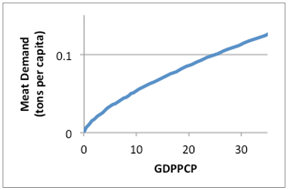International Futures Help System
Meat Demand and Its Calorie Contribution
In the first model year apparent meat demand is used to compute the calories that its consumption contributes to the need of the population. In subsequent years the calculations begin with meat demand again, and conclude with calculation of the calories provided by it. This is needed subsequently to determine the calories required from crops.
In the first year of the model's forecasts an apparent consumption of meat is calculated as for other agricultural demand components (in terms of production plus imports and subtracting exports). In the first year, two other country-specific values are calculated that are used to estimate this value in the forecast years—meatmaxr and meatactpredrat.
meatmaxr is a country-specific maximum for per capita meat demand in tons. It is calculated as the maximum of a global parameter ( meatmax ) and per capita total meat demand (AGDEM, category 2 divided by POP).
meatactpredrat, which acts as a shift factor, is the ratio of actual total meat demand (in tons) to a predicted value (MeatDem). First, a predicted per capita value is estimated as an increasing function of GDP per capita [1] :

This is not allowed to exceed meatmaxr and is then multiplied by the population to yield the predicted value of total MeatDem. meatactpredrat is then calculated as

meatmaxr is held constant in all forecast years. For most countries, the value of meatactpredrat gradually converges to 1 over a period given by the global parameter agconv . The exception is for certain countries in South Asia, specifically India, Nepal, and Mauritius, for which it does not converge. In either case, it is represented in equations in future year as adjustforinitialdevm.
In the forecast years, IFs then computes the demand for meat in tons as a function of population, average income, world food prices, the shift factor, and a multiplier that allows users to directly increase or decrease demand. As in the first year, per capita demand (tonspercap) is initially estimated as a function of average income, using the same function presented above. This is then converted to total demand in the following equation.
![]()
where
elasmd is a global parameter representing the elasticity of meat demand to changes in the world price relative the first year
A number of further adjustments are made to the meat demand, in the following order:
- The estimated value is restricted to be no greater than that given by multiplying the size of the population (POP) by the maximum for per capita meat demand in tons (meatmaxr)
- This adjusted value is multiplied by a demand multiplier ( agdemmr,f=2 ), which can raise or lower demand.
- If the initial estimate of calories from meat (calfrommeat) exceeds the maximum amount of calories allowed to come from meat, given by calmeatm * caldem, then the demand for meat in tons is recalculated as:

Note that this implies a reduction in the total demand for meat in tons.
In order to undertake the third adjustment, and to prepare for the calculation of calories needed from crops, the meat demand needs to be converted from tons to calories. An initial estimate of calories from meat (calfrommeat) is calculated from the total demand for meat in tons, adjusted by lvcfr and sclavf:
![]()
Should this exceed the maximum amount of calories allowed to come from meat, given by calmeatm * caldem, then two adjustments are made. First, calfrommeat is set equal to this maximum amount
![]()
and the total demand for meat in tons is recalculated
![]()
Note that this implies a reduction in the total demand for meat in tons.
Now that the demands for total calories and calories from meat are known, calories to be demanded from crops (mostly grain) can be calculated simply as
![]()
 International Futures at the Pardee Center
International Futures at the Pardee Center